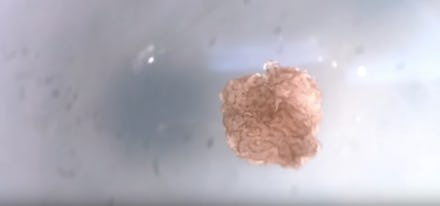Sitting in a petri dish in the laboratories of Tufts University and the University of Vermont are a new kind of life form — half living cells and half machine. Xenobots are a scientific and technological breakthrough — a living organism that is fully programmable, capable of changing form and function essentially on command. The new type of bot was first introduced earlier this year, and thanks to a report from the New York Times, we now have a look behind the process of creating the novel creatures that have the potential to bridge the divide between the mechanical and biological.
Xenobots are not like any creature you've seen before. In fact, you can't really see them at all. These so-called living machines look like little more than a speck to the naked eye, measuring up at about one millimeter wide. The idea for the new organisms was first dreamed up on a supercomputer at the University of Vermont. Researchers ran hundreds of simulations using what they called an "evolutionary algorithm" that would simulate different types of cells. It finally landed on the design for what would become the Xenobot. To bring that design to life, scientists scraped thousands of living skin cells from frog embryos — specifically the African clawed frog Xenopus laevis, hence the name Xenobot. After separating the cells and allowing them to incubate, the researchers used a tiny forceps and electrode to cut and assemble the cells under a microscope until they were assembled in a way that matched the supercomputer's blueprint.
The end result is a completely biological machine that can be manipulated and programmed to take on different forms and complete a myriad of tasks. Xenobots can be designed to have legs that allow them to navigate more challenging terrain or swim or link to each other using appendages. According to the New York Times, the designs were done by roboticists in computer simulations using “physics engines similar to those in video games like Fortnite and Minecraft.” The bots can also heal themselves, recovering from damage including being almost completely ripped in half. They don't last long — just a week, typically — but they also leave little trace once their run has come to an end. Researchers say the machines are fully biodegradable and behave the same as dead skin cells.
As for what the xenobots are capable of, that is largely yet to be seen. The supercomputer simulations created a variety of different kinds of Xenobots, each with a different task in mind. Some could be programmed to move together toward a target, some could even pick up a payload and deliver it to a specific place inside the body. It's possible, too, that the living machines may learn to do more beyond just what they are initially programmed for. Researchers found that when left in a petri dish, the tiny bots would move in circles and push pellets into a central location — a task they completed collectively but entirely of their own accord. The potential for the tiny bots to be equipped with machine learning and artificial intelligence capabilities could allow them to effectively evolve to serve any number of purposes. For now, Xenobots exist right on the border of living and machine, raising new questions about the ethics of such a creation and just what it might be used for in the future.
